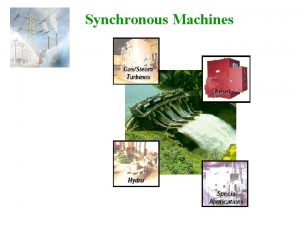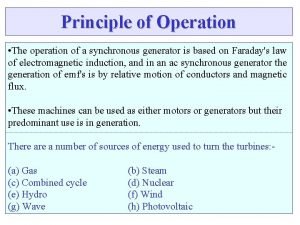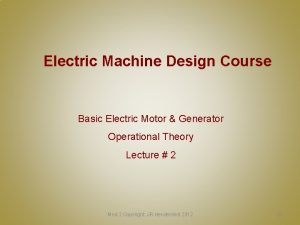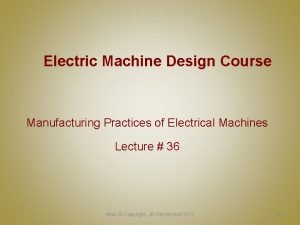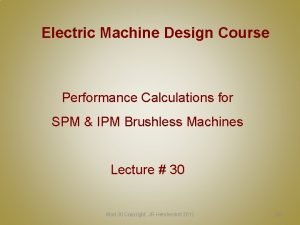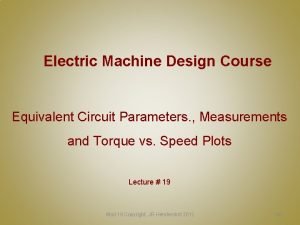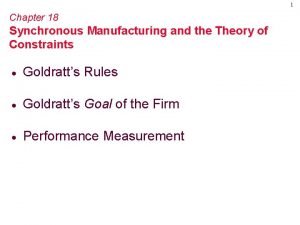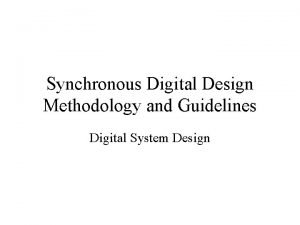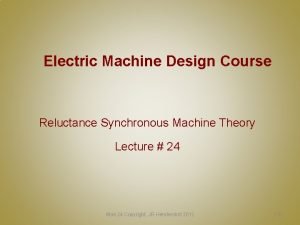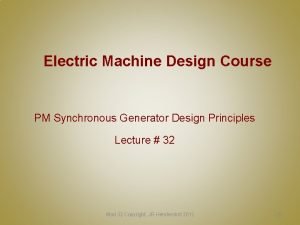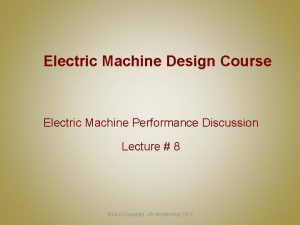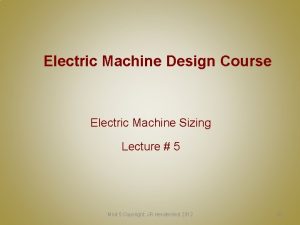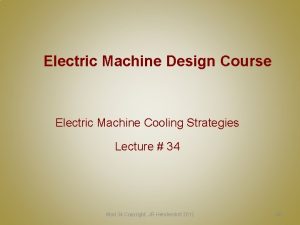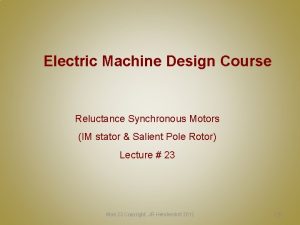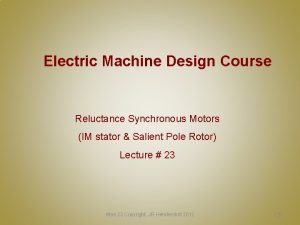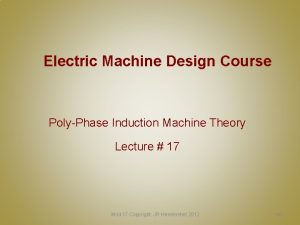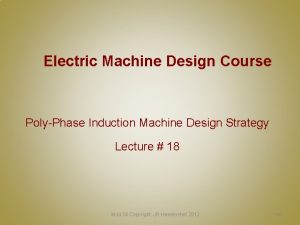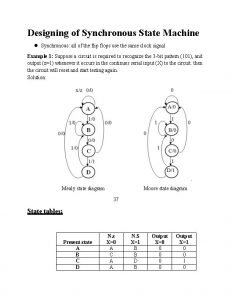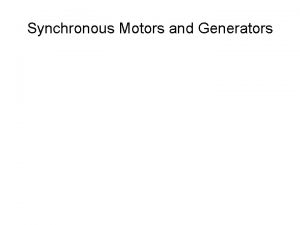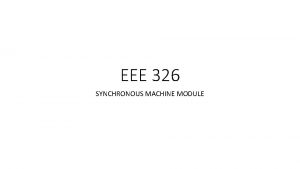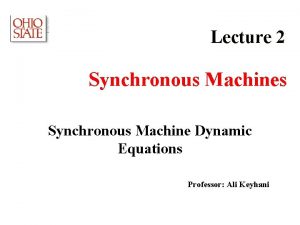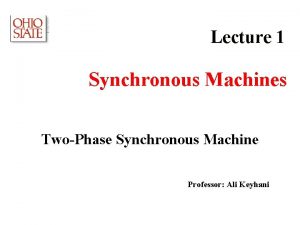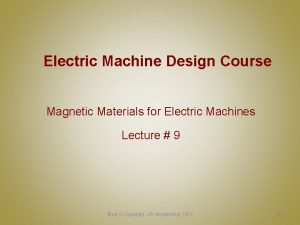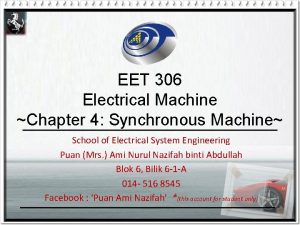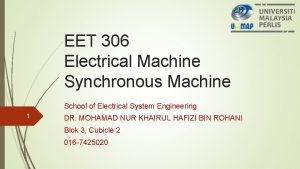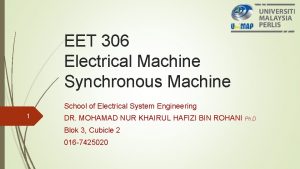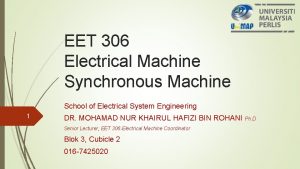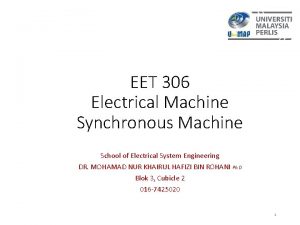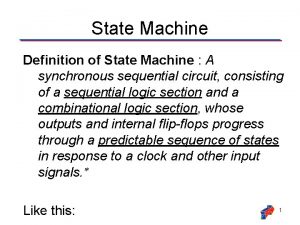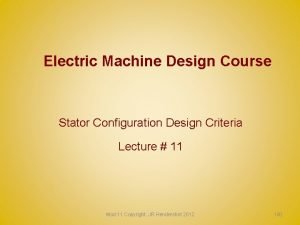Electric Machine Design Course PM Synchronous Design Theory














![Peak Motor Voltage Constant Ke [Vs/rad] Peak flux linkage per phase This becomes the Peak Motor Voltage Constant Ke [Vs/rad] Peak flux linkage per phase This becomes the](https://slidetodoc.com/presentation_image_h2/76623031beb8e9bb745fab74bb9c1672/image-15.jpg)
![Peak Motor Torque Constant Kt [Nm/A] For PMDC motors Kt (Nm/A) = Ke (Vs/Rad) Peak Motor Torque Constant Kt [Nm/A] For PMDC motors Kt (Nm/A) = Ke (Vs/Rad)](https://slidetodoc.com/presentation_image_h2/76623031beb8e9bb745fab74bb9c1672/image-16.jpg)











- Slides: 27

Electric Machine Design Course PM Synchronous Design Theory, SPM & IPM Rotor Types Lecture # 28 Mod 28 Copyright: JR Hendershot 2012 270

Introduction for PMDC (PMDC & PMAC are the same motor type) PMDC, BLDC or Brushless DC (Permanent magnet brushless DC motors): - Inner, outer or axial SPM rotors (surface permanent magnets) - Back emf seldom sinusoidal, usually sort of flat-topped - Magnet configuration can be arc shaped or bread-loaf shaped - Driven with “ 6 -sep” drive, 120 deg. E commutation “Unipolar” drive with (3) transistors, (1) phase produces torque 1/3 of stator copper utilized for producing torque & power “Bipolar” drive with (6) transistors, (2) phases produce torque 2/3 of stator copper utilized for producing torque & power - Stator designs typically utilize phase coils placed around single teeth - Commutation requires shaft angle sensors or sensorless feedback - Speed (rpm) is proportional to DC rail voltage Mod 28 Copyright: JR Hendershot 2012 271

Introduction for PMAC or PMSM (PMDC & PMAC are the same motor type) PMAC, PMSM (Permanent magnet synchronous motor): - Inner SPM or IPM rotors (surface or internal magnets) - Sinusoidal back emf is desired with minimum harmonic content - Surface magnet configuration can be arc shaped or bread-loaf shaped - Internal magnet shapes usually simple rectangular blocks - Driven with hysteresis current control, 180 deg. E commutation With (6) transistor drive, all (3) phases produces torque 100% of stator copper utilized for producing torque & power Requires shaft pole or position feedback, censored or sensorless - Field oriented current control Id & Iq (6) transistor bridge allows all three phases to produce shaft torque Requires censored or measured Ld & Lq commutation - Stator designs typically designed to facilitate sine shaped back emf One or more slots (& coils) per pole per phase Skew or rotor or stator or magnet pole shaping to vary air gap Mod 28 Copyright: JR Hendershot 2012 272

Back EMF comparison Ideal Sine back EMF Ideal trapezoidal back EMF Mod 28 Copyright: JR Hendershot 2012 273

Circuit Voltage Equations Following equations are true with constant phase inductance R = Resistance L = Inductance v = Terminal voltage e = Induced voltage i = Current Φ = Flux Ψ = Flux-Linkage It is not necessary to use these equations for initial design purposes. A simple back EMF equation can be used for sizing the design for effective turns FEA analysis is used for final machine design analysis Mod 28 Copyright: JR Hendershot 2012 274

Voltage & Torque relationship for PM Brushless machines Mod 28 Copyright: JR Hendershot 2012 275

Useful flux linkage equation for initial design The PM rotor makes turns/coil calculation estimates easy Assume Ke ~ Kt and then use the following relationship: V-sec/Rad ~ Nm/amp Z = total number of active conductors p = number of poles Φ = active air gap flux/pole Assumes one parallel current path Mod 28 Copyright: JR Hendershot 2012 276

PM gap flux using soft iron pole concentrators Mod 28 Copyright: JR Hendershot 2012 277

IPM components Shin-Etsu Mod 28 Copyright: JR Hendershot 2012 278

(8) Pole IPM AC synchronous motor Td from magnets Toyota (2004) Prius (48) Slots, (8) poles (2) Magnets/pole “V” shaped Salient soft iron poles between magnet poles. Tq from salient poles Mod 28 Copyright: JR Hendershot 2012 279

IPM torque components Mod 28 Copyright: JR Hendershot 2012 280

IPM Equivalent Circuits d-axis equivalent circuit q-axis equivalent circuit Mod 28 Copyright: JR Hendershot 2012 281

Air-Gap flux vs magnet grade Mod 28 Copyright: JR Hendershot 2012 282

Torque and voltage relationship for brushless permanent-magnet machines Kt = torque constant & Ke = voltage constant For a PM brushed servo motors, Kt = Ke (SI units, Nm/A = V/rad/sec) For a PM brushless Kt can be equal to Ke if the voltage term is properly defined (peak, mean or rms). (See chapter 8, page 405 Design of Brushless Permanent-Magnet Machines ISBN 978098068708) The stator of a PM brushless machine usually has three phases or more, such as six, if a dual inverter bridge is used to share current. Phase or line-line output voltage shapes are either square wave or sine wave or anything in between depending the nature of the flux linkage due to magnet pole arc, slot/pole ratio winding pitch & skew. Mod 28 Copyright: JR Hendershot 2012 283
![Peak Motor Voltage Constant Ke Vsrad Peak flux linkage per phase This becomes the Peak Motor Voltage Constant Ke [Vs/rad] Peak flux linkage per phase This becomes the](https://slidetodoc.com/presentation_image_h2/76623031beb8e9bb745fab74bb9c1672/image-15.jpg)
Peak Motor Voltage Constant Ke [Vs/rad] Peak flux linkage per phase This becomes the average phase EMF during 120 deg. rotation For L-L EMF there are two phase in series and taking into account that each phase coil has two sides which are linked by the flux the equation for the peak Ke or back EMF constant is: [Vs/rad] The above equation is for wye connected (6) step machines. If the phase windings are connected in delta, the 2/3 factor above is replaced by 1/3. (See page 180 in ISBN 978 -09840687 -0 -8) Mod 28 Copyright: JR Hendershot 2012 284
![Peak Motor Torque Constant Kt NmA For PMDC motors Kt NmA Ke VsRad Peak Motor Torque Constant Kt [Nm/A] For PMDC motors Kt (Nm/A) = Ke (Vs/Rad)](https://slidetodoc.com/presentation_image_h2/76623031beb8e9bb745fab74bb9c1672/image-16.jpg)
Peak Motor Torque Constant Kt [Nm/A] For PMDC motors Kt (Nm/A) = Ke (Vs/Rad) This does not hold true for PMAC synchronous brushless machines because of the number of phases and the wide variety of back EMF shapes. (As shown on a previous slide) Assuming close to equal relationship is very useful for first approximations for the design process but frequently, multiplying line current times the Kt will not yield torque values equal to measured values. See chapter # 8 in ISBN 978 -0 -9840687 -0 -8 for a detailed and rigorous analysis of this topic including comparison charts on page # 422. Mod 28 Copyright: JR Hendershot 2012 285

Permanent-Magnet Synchronous Generators Any PM brushless machine can be operated as a generator The machine can have surface rotor magnets of imbedded magnets The power flow from motoring to generating is reversed A prime mover (engine, turbine or other) supplies driving torque A back EMF proportional to rpm is produces from line to line. The output voltages from each line to line lead can be rectified using a simple diode bridge or an active transistor rectifier circuit. Voltage regulation via prime mover speed control is seldom used A down chopper is used to regulate Voltage for diode rectification The active transistor bridge boosts the voltage for desired regulation Mod 28 Copyright: JR Hendershot 2012

Permanent-Magnet Synchronous Generator Theory Load types: Open Circuit, Short Circuit, Infinite Bus (grid), Diode Rectifier, passive Impedance & Active Rectifier (transistors) For Diode rectifier with down chopper for regulation the EMF is designed to be 25% to 50% higher the regulated DC voltage. For active transistor rectification-voltage regulation, the EMF is designed to be 25% to 50% lower than the regulated DC voltage. (sometimes known as a boost regulator) SPM generators exhibit very little voltage drop with load. IPM generators can exhibit considerable voltage drop with load PM motors generate if commutation is 180 deg from motoring Mod 28 Copyright: JR Hendershot 2012

Permanent-Magnet Synchronous Generator Regulation with Diode Rectification Direct Inductive. Resistive load or DC output regulated with Transistor type Down-Chopper I LOAD V Mod 28 Copyright: JR Hendershot 2012

Permanent-Magnet Synchronous Generator Active Transistor Rectifier-Regulation Mod 28 Copyright: JR Hendershot 2012

PMG load P. F. & regulation PMG to Infinite Bus (Wind turbine) Voltage regulation curves with lagging P. F. For a more rigorous discussion of PMG performance connected to different loads see chapter 9 in ISBN 978 -0 -9840687 -0 -8 Mod 28 Copyright: JR Hendershot 2012

Torque for square wave driven brushless motor DR. TJE MILLER Mod 28 Copyright: JR Hendershot 2012 291

Title Mod 28 Copyright: JR Hendershot 2012 292

Title Mod 28 Copyright: JR Hendershot 2012 293

Title Mod 28 Copyright: JR Hendershot 2012 294

Title Mod 28 Copyright: JR Hendershot 2012 295

Title Mod 28 Copyright: JR Hendershot 2012 296
 Difference between alternator and synchronous motor
Difference between alternator and synchronous motor What is load angle
What is load angle Electric motor design course
Electric motor design course Electric machine design
Electric machine design Spm design course
Spm design course Electric machine design training
Electric machine design training Synchronous manufacturing
Synchronous manufacturing Electric field equation
Electric field equation Potential due to a dipole
Potential due to a dipole Electric potential energy
Electric potential energy Electric field from electric potential
Electric field from electric potential A suitable electric pump in an electric circuit is a
A suitable electric pump in an electric circuit is a Chapter 21 electric charge and electric field
Chapter 21 electric charge and electric field Chapter 21 electric charge and electric field
Chapter 21 electric charge and electric field Chapter 16 electric charge and electric field
Chapter 16 electric charge and electric field Units of a charge
Units of a charge Electric charges and electric forces lesson outline
Electric charges and electric forces lesson outline Synchronous digital system
Synchronous digital system Present state next state table
Present state next state table Header bond t junction
Header bond t junction Course number and title
Course number and title Chaine parallèle muscle
Chaine parallèle muscle Welded wire mesh machine
Welded wire mesh machine Cmu machine learning
Cmu machine learning Introduction to machine learning slides
Introduction to machine learning slides Finite state machine vending machine example
Finite state machine vending machine example Mealy and moore sequential circuits
Mealy and moore sequential circuits Moore machine to mealy machine
Moore machine to mealy machine
